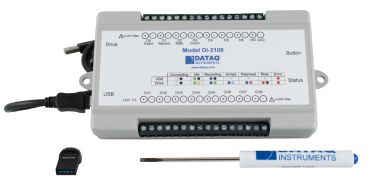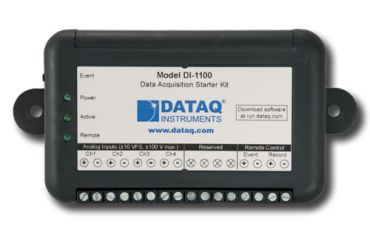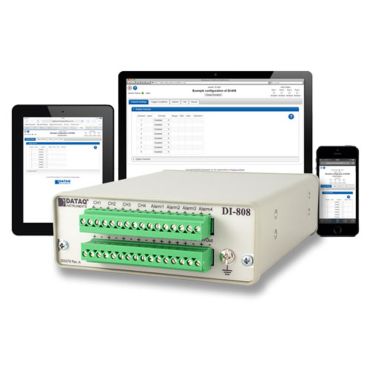Dataq DI-2108-P High Speed data Acquisition
Dataq DI-2108-P, High-speed, 16-bit, Expandable USB DAQ
● 4 or 8 armored analog differential inputs
- ±2.5, ±5, ±10, 0-5, 0-10 Volts
- Up to ±300 V without damage
● Up to 160 kHz sample throughput rate
● Optional upgrade to Stand-alone Datalogger
● Supports ChannelStretch™ multi-unit synchronization
- Up to sixteen instruments
- Up to 480 kHz throughput
- Up to 128 analog channels and 112 digital ports
● Seven digital I/O ports
- Programmable per port as input or switch
- Support for frequency measurements to 50 kHz
- Support for 16-bit counter
● Wide-ranging software support includes:
- Ready-to-run WinDaq software
Model DI-2108-P |
   |
High-speed, 16-bit, Expandable USB Data Acquisition (USB DAQ)
The Analog Subsystem
Model DI-2108-P delivers premium analog performance at a surprisingly affordable price. Eight analog input channels provide differential measurement flexibility and programmable ±2.5, 5, 10 V bipolar and 0-5 and 0-10 V unipolar ranges per channel. The differential input configuration provides noise rejection, easily adapts to single-ended signal sources, and is protected up to ±300 V dc or peak ac so that inevitable measurement mishaps will not harm the instrument. Bipolar ranges measure signals above and below zero, while resolution is effectively doubled on unipolar ranges. The front end feeds a fixed resolution, 16-bit ADC. The maximum sampling throughput rate of the DI-2108-P is 160 kHz.
Supports ChannelStretch™ Technology for multi-unit synchronization
- Up to sixteen instruments
- Up to 480 kHz throughput
- Up to 128 analog channels and 112 digital ports
Synchronous channel expansion that's as easy as plugging in another device
Wouldn't it be EASY to simply connect multiple, low-cost USB devices to one PC and have them acquire data synchronously across units?
Wouldn't it be PRODUCTIVE to acquire dozens of analog and digital channels across multiple instruments to one application and file, just as though from a single device?
Wouldn't it be FLEXIBLE to easily scale measurement capacity up or down at will as your requirements change?
Convenient, productive, and flexible describe the ChannelStretch™ approach to scaling analog and digital channel capacity in USB data acquisition (USB DAQ) applications. It is novel technology developed by DATAQ Instruments that allows multiple data acquisition instruments to synchronize to within 10 micro-seconds between any two units. And, it's easy to implement and manage.
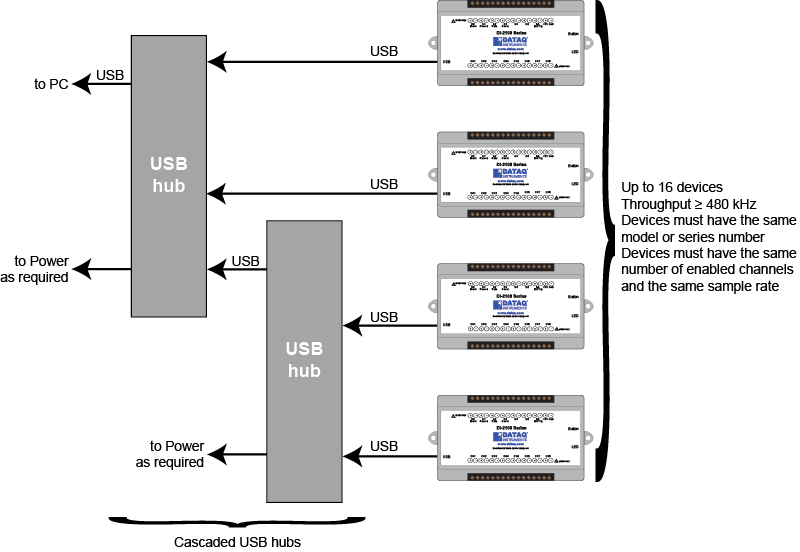
Up and Running in Three Easy Steps
ChannelStretch™ is as easy to implement as 1-2-3:
1. Get a USB hub and 2-16 supported data acquisition devices that share the same model or series number. If you run out of hub ports, simply cascade more hubs until you have enough. DATAQ Instruments sells a 7-port hub for this purpose, but almost any hub will work.
2. Connect your USB data acquisition instruments to the hub ports.
3. Use software you designed, or our ready-to-run WinDaq software and begin acquiring up to 128 analog channels and 112 digital ports at a maximum sample throughput rate of at least 480 kHz.
|
The WinDaq Software AdvantageWinDaq Data Acquisition Software |
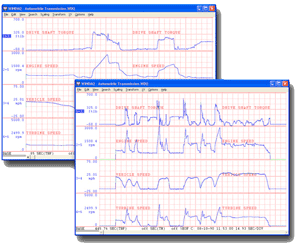 |
Digital Port Subsystem
The DI-2108-P provides 7 digital ports, each configurable as an input or a switch. Input protection is provided to 30 V. When activated as inputs two ports allow dual functionality as discrete inputs, or programmed as a counter or rate input. The rate input features a 50 kHz maximum measurement allocated over twelve programmable measurement ranges (10 Hz to 50 kHz full scale.) The counter input provides 16-bit resolution and a terminal count value of 65,535. The discrete, counter, and rate inputs are members of the same internal scan list used by the analog input channels. This means that all enabled elements are acquired synchronously, which allows meaningful comparisons between analog and digital channels. For example, the rate input measuring engine speed allows rpm data to be acquired in lock-step with analog data. Configured as a switch a digital port can be used to control external loads up to 30 V @ 100 mA, and the switch can be controlled asynchronously without interfering with the scanning process.


